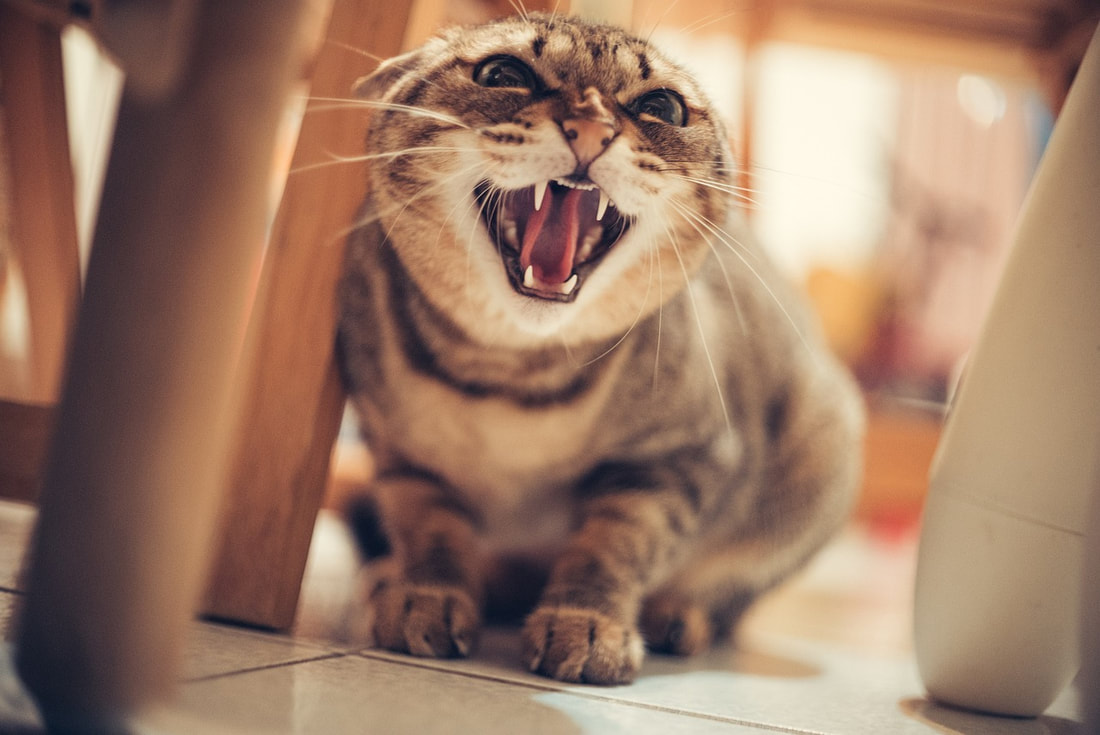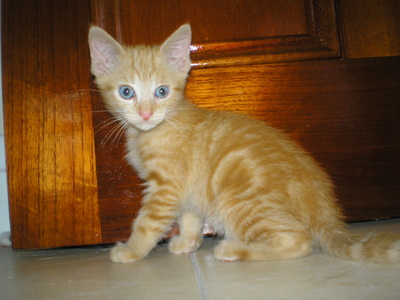Feline Body Language
Feline Body Language is an elaborate sophisticated set of body postures, facial expressions and ear movements. Cats will use these signals to communicate fear, anxiety, excitement, happiness and aggression.
Relaxed Cat
Relaxed Cat
- A relaxed cat will have its tail down and held in a U shape as it walks around, and when greeting other pets or people with which he is comfortable will approach with the tail raised and sometimes with a curl at the end like a question mark.
- If the cat is resting, he may be on his back exposing his belly, or curled up with the tail loosely wrapped and his feet off the ground.
- The tail of a relaxed cat, may wrap around another companion pet or family member. The cat is relaxed and enjoying the social interaction.
- A relaxed cat has upright ears, usually pointed slightly to the side and slightly forward. The whiskers point to the side and pupils moderately dilated (depending on available light). The eyes may be half closed and a slow blink may be directed towards people or other pets as a non-confrontational greeting. The cat is content.
- A cat may purr when relaxed, or meow as a friendly greeting. Some cats such as Siamese are greater talkers than others.
Increased Arousal
- A nervous cat will have ears that are twitching. His eye may be open with dilated pupils and the whiskers are tensed (point downward).
- The tail may have a slow swish indicating the cat is focused or interesting in something – it may be a bird, a toy or your wiggling toe
Potential Aggression
Frightened
- If your cat begins whipping his tail from side to side, if often indicates they are annoyed or irritated by something. This can quickly escalate to an aggressive display.
- A cat that is showing signs of arousal or aggression holds their tail close to their body
- An aggressive cat will have ears that turn back from a forward to a backward facing posture, and the pupils may constrict (get smaller).
- A conflicted or undecided cat will switch ear position back and forward from flattened and turned back.
- A fearful or defensively aggressive cat may growl, hiss and spit.
Frightened
- A frightened cat will arch his back and raise his tail – the hair along the cats back and tail will be raised or fluffed out – this makes the cat look bigger, and hopefully scares away whatever has frightened it.
- When frightened the cats ears will fold back from the forward upright position to a flattened sideways position against their head, the pupils dilate and the eyes are wide open. The whiskers will be held stiffly out to the side.
- A fearful or defensively aggressive cat may growl, hiss and spit.
References
1. Aspinall, V., 2006.The complete textbook of veterinary nursing. 1st ed. Edinburgh; Butterworth Heinemann Elsevier
2. Cooper, B., Turner, L. and Mullineaux, E., 2011. The BSAVA textbook of veterinary nursing. 1st ed. Gloucester [England]: British Small Animal Veterinary Association.
3. Horwitz, D. and Mills, D., 2009. BSAVA manual of canine and feline behavioural medicine. 1st ed. Quedgeley, Gloucester [England]: British Small Animal Veterinary Association.
1. Aspinall, V., 2006.The complete textbook of veterinary nursing. 1st ed. Edinburgh; Butterworth Heinemann Elsevier
2. Cooper, B., Turner, L. and Mullineaux, E., 2011. The BSAVA textbook of veterinary nursing. 1st ed. Gloucester [England]: British Small Animal Veterinary Association.
3. Horwitz, D. and Mills, D., 2009. BSAVA manual of canine and feline behavioural medicine. 1st ed. Quedgeley, Gloucester [England]: British Small Animal Veterinary Association.













